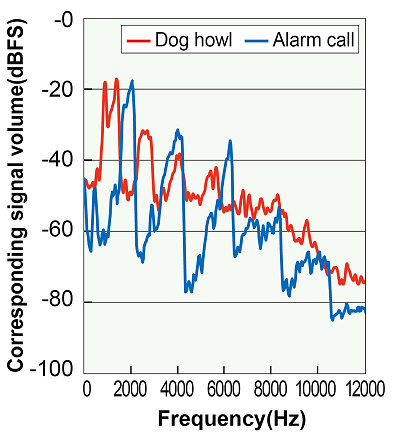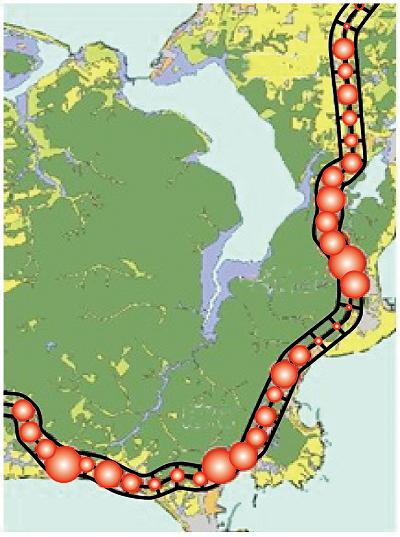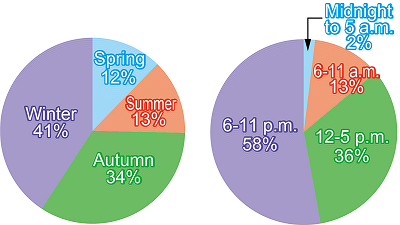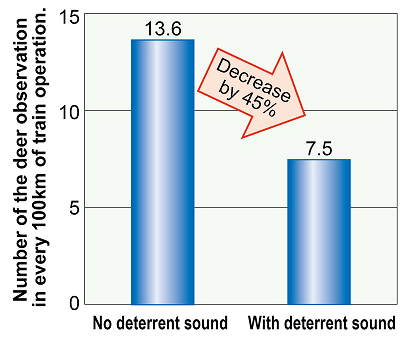8. Development of a deterrent sound to prevent Deer-Train Collisions
Growing deer populations and expanding deer habitats have led to an increase in deer-train collisions. Railway companies have implemented various countermeasures for this, for example fences to keep deer out or deer repellents. These measures were effective to some extent, however they did not ultimately reduce collision numbers significantly. A deterrent sound was therefore designed as a new solution to add to existing measures, which would deter deer from being around the track, and an application to have this sound emitted from trains as a method for avoiding deer-train collisions was proposed.
It is known that deer emit an “alarm call” to signal a danger to other deer. We confirmed that deer paid attention to the direction from which an alarm call came from when we sound alarm call artificially. It is also known that deer avoid dogs, therefore, the deterrent sound was designed with the sound of alarm call and a sound of a dog howl (Fig.1).
The deterrent sound is based on the premise that the first alarm call will alert the deer, while the following howling sound will deter the deer from the track. In order to emit this sound from a train, previous deer-train collisions were mapped out using a geographical information system (GIS) based on actual collision data (Fig. 2) while taking into account features such as vegetation and landscape topography, in order to propose an accompanying method to select areas where the sound should be emitted.
The deterrent effect of the developed sound was evaluated during peak collision periods, i.e. at night time during the winter (Fig. 3), where the deterrent sound was emitted from the front of the train in the pre-selected areas based on the deer-train collision map. The trials proved successful and reduced the frequency of deer observations by 45% (Fig. 4). By inferring that deer were frightened away from the track because of the deterrent sound emitted by approaching trains, these trials confirmed the effectiveness of this new measure.
 Fig. 1 Spectra of alarm call and dog howl used in deterrent sound
Fig. 1 Spectra of alarm call and dog howl used in deterrent sound
 Fig. 2 Train-deer collision map (the diameter of the ● associates with number of collisions)
Fig. 2 Train-deer collision map (the diameter of the ● associates with number of collisions)
 Fig. 3 Proportion of events by season (3,070 events) (left) and according to time of day (right)
Fig. 3 Proportion of events by season (3,070 events) (left) and according to time of day (right)
 Fig. 4 Decrease in the number of the deer observation by virtue of emitting the deterrent sound
Fig. 4 Decrease in the number of the deer observation by virtue of emitting the deterrent sound
Other Contents
- 1. Effectiveness of embankment slope work against cloudbursts
- 2. Development of seismic reinforcement methods for bridge abutment and proposal for new design method
- 3. Fracturing grouting as a countermeasure against soil liquefaction
- 4. Anti-seismic measures using a vibration control damper
- 5. Bogie designed to prevent flange climb derailment
- 6. Method for evaluating running safety in case of punctured air spring
- 7. Wireless communication network for monitoring of freight car condition
- 8. Development of a deterrent sound to prevent Deer-Train Collisions
- 9. Training material to prevent communication errors
- 1. Effectiveness of embankment slope work against cloudbursts
- 2. Development of seismic reinforcement methods for bridge abutment and proposal for new design method
- 3. Fracturing grouting as a countermeasure against soil liquefaction
- 4. Anti-seismic measures using a vibration control damper
- 5. Bogie designed to prevent flange climb derailment
- 6. Method for evaluating running safety in case of punctured air spring
- 7. Wireless communication network for monitoring of freight car condition
- 8. Development of a deterrent sound to prevent Deer-Train Collisions
- 9. Training material to prevent communication errors
